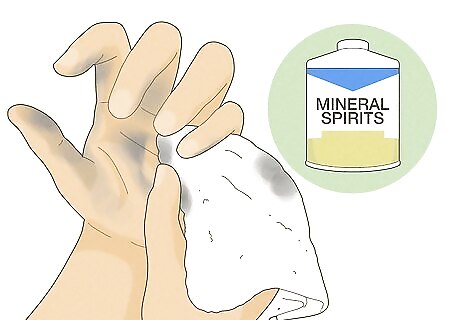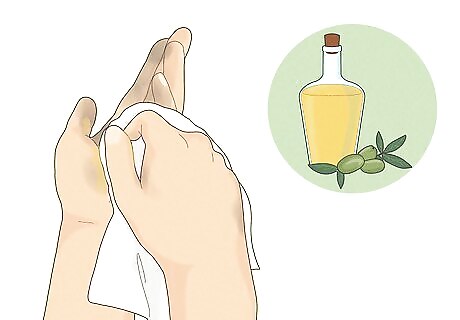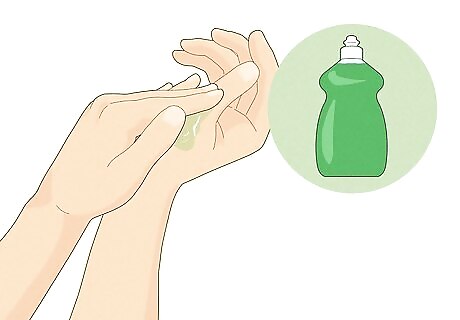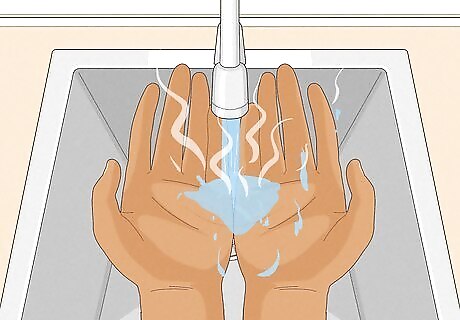
views
X
Research source
If you're tackling a DIY project and got polyurethane on your hands, fear not! This guide will teach you how to remove it using common home solvents and more.
- Remove oil-based polyurethane using mineral spirits or paint thinner. Or, try cooking oil mixed with salt or nail polish remover.
- Remove water-based polyurethane using warm water and dish soap, or by scrubbing the area with a pumice stone.
- Wash your hands thoroughly when you've removed the polyurethane and then apply hand lotion to moisturize your skin.
Removing Oil-Based Polyurethane

Apply mineral spirits for a quick option. Only use mineral spirits if you have access to a well-ventilated room without the risk of flames, like a bathroom with an open window. Using an old hand towel or rag, apply enough mineral spirits to soften the oil-based polyurethane from your hands.

Use vegetable oil for a gentle solution. You may also use cooking oil, like vegetable oil. Simply dab a rag or paper towel with oil and apply to the polyurethane on your skin. For extra scrubbing power, combine ⁄2 cup (120 mL) of olive oil (or another oil for your choice) and 1/3 cup (96 g) of salt and stir. Scoop a generous amount and rub the mixture into your skin for approximately 2 to 3 minutes to remove the stain.

Try paint thinner. Pour enough paint thinner to coat your hands onto a rag or paper towel. Wipe down each part of your hand before rinsing with soap and hot water.

Use rubbing alcohol or denatured alcohol. Pour a decent amount of alcohol onto a rag or paper towel and rub the stained areas until the polyurethane fades. Apply more alcohol if needed. This method will be harsher on your skin, leaving it dry, so moisturize well when you're done.

Apply acetone nail polish remover. If you or someone in your house has nail polish remover with acetone, grab it. Soak a rag, paper towel, or cotton balls in the remover and wipe any polyurethane away. If the polyurethane hasn’t dried onto your skin yet, this is a fast removal method. If it has dried onto your skin, you may need to rub it hard or allow it to soak for a few minutes.

Use soap and warm water to clean your hands. Allow your choice of solvent (mineral spirits, oil, paint thinner) to sit on your skin for a minute. Then, wash your hands with warm water and soap to remove any solvents from your hands. Be sure to rinse thoroughly. If your hands still feel sticky, apply more solvent and repeat the process until your hands are clean.

Finish up with moisturizing lotion. Apply a generous layer of moisturizing lotion to soothe skin irritation and restore moisture to your hands.
Removing Water-Based Polyurethane

Apply dish soap and water. Use a dish soap like Dawn with surfactants, a chemical that can penetrate and lift grease, oil, and dirt from many surfaces. Refer to the back of your dish soap for the ingredients and look for one of the following: Anionic surfactants include Sodium Laurel Sulfate (SLS), Sodium Laureth Sulfate (SLES), and Linear Alkyl Benzene Sulphonic Acid (LABSA). These are the most common surfactants in dishwashing liquids. Nonionic Surfactants are milder and ideal for people with sensitive skin. These include Fatty Alcohol Polyoxyethylene Ether (AEO-9) and Cocamide DEA. Amphoteric Surfactants include Cocamidopropyl Betaine and Cocamidopropylamine Oxide.

Use a pumice stone to scrape off the polyurethane. Loosen and remove polyurethane from your hands by gently rubbing it with your nails. If it's really stuck, use a pumice stone or a sponge with a rough surface to scrape the polyurethane from your hands. If polyethylene has dried on your skin, you may need to soak your hands in warm water and soap for a few minutes.

Rinse your hands under warm water. Rinse your hands under warm water for at least 30 seconds. If there’s still a stain, repeat these steps until your hands are clean.

Apply moisturizing lotion. After you’ve dried off your hands, apply a generous layer of moisturizing lotion to prevent skin irritation and keep your hands soft. Hand cream can also be used as a preventative measure to protect your skin from polyurethane.


















Comments
0 comment